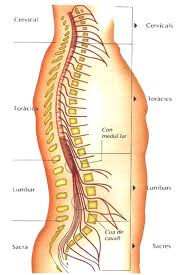Causes , Symptoms and Clinical Features of Spinal Cord Compression:
Disorders localized to the spinal cord or nerve roots are detailed below, but note that many diffuse neurological disease processes also affect the cord.
SPINAL CORD AND ROOT COMPRESSION
As the spinal canal is a rigidly enclosed cavity, an expanding disease process will eventually cause cord and/or root compression.
CAUSES:
Tumours
- Primary
- Secondary
Infection
- Acute
- Chronic
Disc Disease And Spondylosis
- Haematoma
- Cystic Lesions
Manifestations of cord or root compression depend upon the following:
1. Site of lesion within the spinal canal: An expanding lesion outside the cord produces signs and symptoms from root and segmental damage.
- ROOT: Lower motor neuron (l.m.n.) and sensory impairment appropriate to the distribution of the damaged root.
- SEGMENTAL: l.m.n. and sensory impairment appropriate to segmental level. Interruption of ascending sensory and descending motor tracts produces sensory impairment and an upper motor neuron (u.m.n.) deficit below the level of the lesion. Lesions within the cord (intramedullary) produce segmental signs and symptoms.
2. Level of the Lesion: A lesion above the LI vertebral body may damage both the cord and its roots. Below this, only roots are damaged.
3. Vascular involvement: Neuronal damage from mechanical stretching is of less importance than the vascular effects. At first venous obstruction leads to vasogenic oedema, but eventually impaired arterial flow causes irreversible spinal cord infarction. Clinical findings may suggest cord damage well beyond the level of compression, implying a distant ischaemic effect from vessel compromise at the lesion site.
4. Speed of onset: Speed of compression affects the clinical picture. Despite producing upper motor neuron damage, a rapidly progressive cord lesion often produces a ‘flaccid paralysis‘ with loss of reflexes and absent plantar responses. This state is akin to spinal shock seen following trauma. Several days or weeks may elapse before tone returns accompanied by the expected ‘upper motor neuron signs.
CLINICAL FEATURES:
These depend on the site and level of the compressive lesion.
- ROOT: Severe, sharp, shooting, burning pain radiating into the cutaneous distribution or muscle group supplied by the root; aggravated by movement, straining or coughing.
- SEGMENTAL: Continuous, deep aching pain radiating into whole leg or one half of body; not affected by movement.
- BONE: Continuous, dull pain and tenderness over the affected area; may or may not be aggravated by movement.
If you think you may be suffering from discomfort due to nerve root compression, visit your doctor now. In most circumstances, minimal discomfort can be handled through traditional treatments required by your doctor, such as treatment, physical rehabilitation, or massage therapy.Contact the experienced team of neurological specialists at Braner Pain Clinic to learn more about our clinic Contact us at: 1 (877) 573-1282